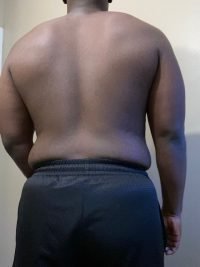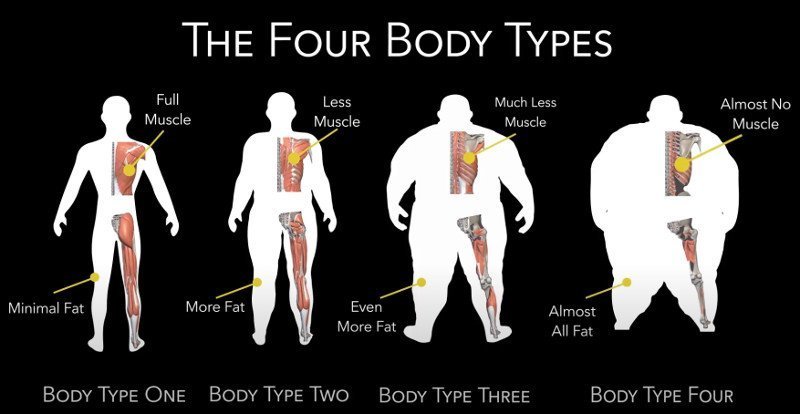FORCA?Fellow One Research Combined Average (FORCA) Health Score which Averages the Self-Determined (SD) Health & FORC Health Scores [5 is Very Healthy, 1 is Very Unhealthy]. This score is in beta testing.
2.95
FORTH?Fellow One Research Total Health (FORTH) Score [5 is Very Healthy, 1 is Very Unhealthy]. This score is in beta testing.
3.45
FORMR?Fellow One Research Metabolism Rate (FORMR) Adjusted Mifflin St Jeor Equation BMR (Basal Metabolic Rate) Score. This score is in beta testing.
Normal Metabolism
Mifflin St Jeor BMR: 1759.62
Adjusted Mifflin St Jeor: 1731.46
FORMA?Fellow One Research Metabolism Activity (FORMA) Adjusted Harris-Benedict Equation Activity Score. This score is in beta testing.
Increased Metabolic Rate
Body Mass Index (BMI) Calculation
27.4
BMI Minimal, Moderate, High Risk
Moderate Risk

Fellow One Research, The Four Body Types Body Type Quiz/Test Participant Bucky Barnes Bio Summary – Body Type Two (BT2)
I have studied The Four (4) Body Types and it is my understanding that I am a Body Type Two (BT2). Obesity has been a serious problem in my life. My obesity problems started in my life between age 1 and age 5. I was at my heaviest weight when I reached 260 pounds at age 19. The most weight I ever lost was 85 pounds when I was 20. I have been successful at keeping all that weight off to date. I gained back 0 of those pounds in a span of 0 month(s).
My ride on the obesity weight gain & loss roller coaster ride has been severe & I can't get off it. If/when I put fat weight on my body, it is most likely that I will put the fat weight on in relation to: buttocks, lower midriff/waist/hips, midriff/abdomen/belly, as accurately as I can figure. I attribute mostly my unbalanced diet to my weight problems. On average, obesity is somewhat/questionably common in my family.
Upon careful examination of my spine, vertebra(e) (posture), and muscle/muscle mass, I am confident that the following vertebra(e) in my body are underdeveloped if not undeveloped: thoracic 5, lumbar 1, lumbar 2, lumbar 3, lumbar 4, lumbar 5, sacrum, as best I can surmise. I am confident I am a Body Type Two (BT2) because I have between (1) and eight (8) vertebrae undeveloped. I am quite sure my body does not look identical to a Body Type One (BT1) with all muscles developed & defined. My body has not always had the fully developed BT1 classic arch, dimples, vertebrae (posture), and muscle mass. I am certain I do not have the fully developed BT1 classic arch and dimples, which strengthens my belief I'm not a BT1.
| Fellow One Research Identifies this ‘The Four Body Types’ Body Type Quiz/Test Research Participant’s Body Type as a: |
| Basic Body Type Quiz/Test Participant Self-Determined (SD) Health Score (5 is Very Healthy, 1 is Very Unhealthy) |
| Basic Fellow One Research Calculated (FORC) Health Score (5 is Very Healthy, 1 is Very Unhealthy)** |
What Does My Body Type Two (BT2) Mean?
Life is all about balance. Unbalance allows a human being to truly understand balance by recognizing, honestly, what their unbalances truly are. All be it some more than others, all human beings are unbalanced physically, mentally, emotionally, and spiritually, at least to some extent. But most human beings are very unbalanced and unhealthy. The more unbalanced the body type (BT4 is the most unbalanced body type), including metabolism, the more physical work the specific individual person has to do to bring their human body into a state of true physical balance (BT1).
Body Type One (BT1): Physically balanced (Anatomy Standard).
| *Fully developed vertebrae, spinal extension (posture), and muscle. *33 out of 33 Vertebrae Developed and Extended, relative to the 24 Moveable & Two Fixed Bones (0 Vertebrae Undeveloped/Underdeveloped) *Very Low to Low probabilities of experiencing obesity in the short and long-terms. *High tendencies to be symmetrical and attractive. *Mental (mind), emotional (energy in motion), and spiritual (soul/soul energy/star power/IT Factor) balance matters equally as much as physical (body/genetics/DNA) balance. |
Body Type Two (BT2): Less Physically Balanced.
| *Mostly developed vertebrae, spinal extension (posture), and muscle. *32 to 22 out of 33 Vertebrae Developed and Extended, relative to the 24 Moveable & Two Fixed Bones (1-8 Vertebrae Undeveloped/Underdeveloped) *Low to Medium probabilities of experiencing obesity in the short and long-terms. *Moderate tendencies to be symmetrical and attractive. *Mental (mind), emotional (energy in motion), and spiritual (soul/soul energy/star power/IT Factor) balance matters equally as much if not more (to make up for physical unbalances) while the BT2 person is achieving to physical (body/genes/DNA) balance. |
Body Type Three (BT3): More Physically Unbalanced.
| *Moderate to mostly undeveloped vertebrae, spinal extension (posture), and muscle. *21 to 11 out of 33 Vertebrae Developed and Extended, relative to the 24 Moveable & Two Fixed Bones (9-17 Vertebrae Undeveloped/Underdeveloped) *Medium to High probabilities of experiencing obesity in the short and long-terms. *Moderate tendencies to be asymmetrical and unattractive. *Mental (mind), emotional (energy in motion), and spiritual (soul/soul energy/star power/IT Factor) balance matters even more (to make up for physical unbalances) while the BT3 person is achieving to physical (body/genetics/DNA) balance. |
Body Type Four (BT4): Mostly to Fully Physically Unbalanced.
| *Mostly to completely undeveloped vertebrae, spinal extension (posture), and muscle. *10 to 0 out of 33 Vertebrae Developed and Extended, relative to the 24 Moveable & Two Fixed Bones (18-26 Vertebrae Undeveloped/Underdeveloped) *High to Very High probabilities of experiencing obesity in the short and long-terms. *High tendencies to be asymmetrical and unattractive. *Mental (mind), emotional (energy in motion), and spiritual (soul/soul energy/star power/IT Factor) balance matters even that much more (to make up for physical unbalances) while the BT4 person is achieving to physical (body/genes/DNA) balance. |
More Fellow One Research Body Type Quiz/Test Participant Data – Bucky Barnes & Skinny Fat, Back Pain, Diet, Exercise, Lifestyle
Skinny Fat & Back Pain
 Skinny fat has not ever been a serious problem in my life. I never experienced the skinny fat phenomenon in the past and/but I am not experiencing the skinny fat phenomenon in my life at present. After reviewing my body, I am experiencing and/or have experienced skinny fat including thin fat, cellulite, crepey skin, loose/saggy skin, and/or normal weight obesity, in general, relative to: nowhere as far as I can tell.
Skinny fat has not ever been a serious problem in my life. I never experienced the skinny fat phenomenon in the past and/but I am not experiencing the skinny fat phenomenon in my life at present. After reviewing my body, I am experiencing and/or have experienced skinny fat including thin fat, cellulite, crepey skin, loose/saggy skin, and/or normal weight obesity, in general, relative to: nowhere as far as I can tell.
On average, I experience back aches and pain. I feel back aches and pains in my body in relation to: lumbar 5 and it is directly relative to my Body Type Two (BT2).
Diet (Food & Drink/Hydration)
| Basic Self-Determined Body Type Quiz/Test Participant Diet Score (5 is Very Healthy, 1 is Very Unhealthy) |
| Basic Calculated Fellow One Research Body Type Quiz/Test Participant Diet Score (5 is Very Healthy, 1 is Very Unhealthy)** |
I believe my daily diet is unhealthy overall. I would say my diet is evenly mixed omnivore. I eat 2 meals per day & they are all nutritionally balanced, but I may not be getting all my nutrients. I eat a fair mix of whole organic and regular food. I excessively/binge drink alcohol a few times per month more than the recommended 1 glass/day women/2 per day men. I drink no more than the equivalent of 4, 8 ounce glasses of clean water daily and I am dehydrated.
Cardio & Resistance (Weight Lifting, Calisthenics (Body Weight), Isometrics/Gravity) Exercise Training
| Basic Self-Determined Body Type Quiz/Test Participant Exercise Score (5 is Very Healthy, 1 is Very Unhealthy) |
| Basic Calculated Fellow One Research Body Type Quiz/Test Participant Exercise Score (5 is Very Healthy, 1 is Very Unhealthy)** |
 In my opinion, my weekly cardio exercise training routine is questionably healthy. I do cardio exercise 1x per week. My training is 90 minutes per day. I like the following types of cardio activities: walking and the like.
In my opinion, my weekly cardio exercise training routine is questionably healthy. I do cardio exercise 1x per week. My training is 90 minutes per day. I like the following types of cardio activities: walking and the like.
My belief is that my weekly resistance exercise training routine is questionably healthy. I do resistance training 90 minutes per day; 5x per week. I enjoy the following kinds of resistance exercise training activities: weightlifting/weight-training as it stands now.
My daily work/job/career is slightly strenuous/active, I at least walk/move a fair amount.
Lifestyle (Career, Relationships, Travel, Hobbies, Sleep, etc.)
| Basic Self-Determined Body Type Quiz/Test Participant Lifestyle Score (5 is Very Healthy, 1 is Very Unhealthy) |
| Basic Calculated Fellow One Body Type Quiz/TestParticipant Lifestyle Score (5 is Very Healthy, 1 is Very Unhealthy)** |
 I think my lifestyle overall is questionably healthy. I get 6.0 to 7.5 hours of sleep per day/night on average. My daily/nightly sleep, on average, is of questionable quality as I can toss & turn, awaking refreshed slightly to moderately each morning. I find I am happiest when I partake in the following lifestyle activities: nothing and such. Over the past 6 months, my average daily stress levels have been high.
I think my lifestyle overall is questionably healthy. I get 6.0 to 7.5 hours of sleep per day/night on average. My daily/nightly sleep, on average, is of questionable quality as I can toss & turn, awaking refreshed slightly to moderately each morning. I find I am happiest when I partake in the following lifestyle activities: nothing and such. Over the past 6 months, my average daily stress levels have been high.
No, my doctor(s) has never diagnosed me with a hormone imbalance that negatively affected my weight. I am not currently dealing with a doctor-diagnosed hormone imbalance that negatively affects my weight.
If my diet, exercise, and lifestyle were all very healthy my body would look 100% identical to a Body Type One (BT1) with all muscles/muscle mass properly developed. My genetics/DNA are the indirect reason for my body type shape; diet, exercise, and lifestyle are the main reason. Yes, the soul is real and plays at least an indirect part in human health.
**Elite Athletes and the Like May Skew Results
Fellow One Research Participant, The Four Body Types’ Free Body Type Shape Quiz Calculator – One Question I Would Like Answered:How Can I Successfully & Permanently Lose Weight? |







